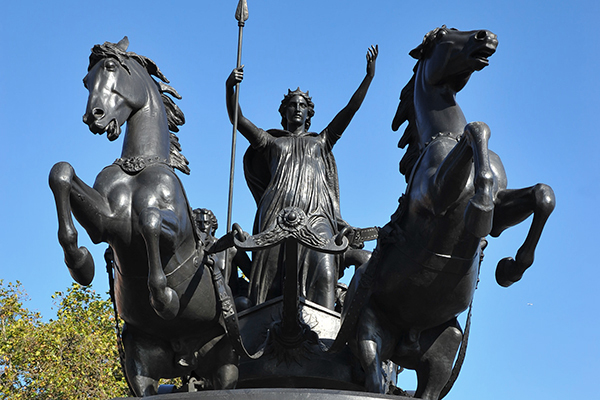

"'We British are used to women commanders in war', she cried. 'I am descended from mighty men! But I am not fighting for my kingdom and wealth now. I am fighting as an ordinary person for my lost freedom, my bruised body, and my outraged daughters....Consider how many of you are fighting—and why! Then you will win this battle, or perish. That is what I, a woman, plan to do!—let the men live in slavery if they will.'"
Tacitus, Annals (XIV.35)
It is not coincidental that Boudica took on legendary proportions for the British people during the reign of Victoria, another great queen. Sponsored by her consort Prince Albert, who provided horses from his stables as models, the great bronze statue of Boudica and her daughters was placed at Westminster Bridge across from the Houses of Parliament in 1902, a symbol of the nation and its imperial ambitions. (The Second Boer War had ended that year.) Built of wicker and wood, the war-chariot of the Britons actually was much lighter and more agile than the one on the embankment of the Thames, where its wheels are fitted with scythes and the rearing horses uncontrolled by reins.
The British Empire then was at its height and Boudica, a patriotic heroine who died defending the liberty of her country against a foreign invader, whose power now had been eclipsed by its former province—or so states the inscription at the base of the statue by the poet William Cowper:
Regions Caesar never knew
Thy posterity shall sway.The lines are from Boadicea: An Ode, written in 1782, and spoken by a Druid to a bleeding Boudica who, upon hearing them, rushes into battle, asserting in the last quatrain of the poem—
"Ruffians, pitiless as proud,
Heaven awards the vengeance due:
Empire is on us bestowed,
Shame and ruin wait for you!"The sentiment of a Rome that "tramples on a thousand states" draws upon the account of Tacitus (Annals, XIV.35), who presents Boudica as a woman wronged. Cassius Dio (Roman History, LXII.7), on the other hand, considers the revolt of the Iceni to be that of cruel barbarians. Certainly, Tennyson portrays the queen as more bloodthirsty in these lines from Boädicéa (written in 1859 but not published until 1864).
"'Burst the gates, and burn the palaces, break the works of statuary,
Take the hoary Roman head and shatter it, hold it abominable,
Cut the Roman boy to pieces in his lust and voluptuousness,
Lash the maiden into swooning, me they lash'd and humiliated,
Chop the breasts from off the mother, dash the brains of the little one out,
Up my Britons, on my chariot, on my chargers, trample them under us.'So the queen Boädicéa, standing loftily charioted,
Brandishing in her hand a dart and rolling glances lioness-like,
Yell'd and shriek'd between her daughters in her fierce volubility.
Till her people all around the royal chariot agitated,
Madly dash'd the darts together, writhing barbarous lineaments..."A symbol both to Tacitus and Dio, Boudica has continued to reflect the biases and prejudices of those who appeal to her, the events of the past interpreted to suit the requirements of the present.
Tacitus writes that the Britons made no distinction in the sex of their leaders but were used to women commanders in war, the most famous of whom were Cartimandua, queen of the Brigantes, and Boudica, queen of the Iceni. Cartimandua capitulated to Rome soon after the Claudian conquest and grew rich and prosperous as a result. When the British patriot Caratacus sought refuge in her kingdom, she handed him over to Rome, which defended her in the civil war that later resulted. And, when the Iceni rebelled, it was Cartimandua who held back the Brigantes, the largest in Britain, from coming to their aid. At first, the Iceni, too, had been a client kingdom of Rome. But, with the death of Prasutagus, his consort Boudica led the people in failed revolt. Boudica poisoned herself and the survivors starved—two British queens who responded so differently to Roman domination.
Reference: Boudica: Iron Age Warrior Queen (2005) by Richard Hingley and Christina Unwin (the first half of which, by Hingley, reviews the archaeological and documentary evidence for Boudica and the second, by Unwin, the literary representation of Boadicea). Reviewed by Rosalind Niblett in Britannia, 37 (2006), 489-492.
![]()